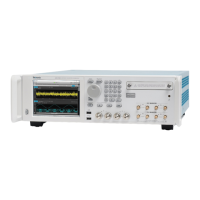Maintenance
Inspect the int
ernal portions of the instrument for damage and wear, using the
following table as a guide. Defects should be repaired immediately.
CAUTION. To prevent damage from electrical arcing, ensure that circuit boards
and components are dry before applying power to the instrument.
Table 4-2: Internal inspection checklist
Item Inspect for Repair action
Front and Rear
Case
Cracks or deformations. Scratched
lettering
or display filter. Loose
connectors or labels.
Repair or replace
defective hardware.
Circuit boards
Loose, br
oken, or corroded solder
connections. Burned circuit boards.
Burned, broken, or cracked circuit-run
plating.
Remove failed module
and replace w ith a new
module.
Solder c
onnections
Cold sol
der or rosin joints.
Resolder joint and clean
with eth
yl alcohol.
Wiring and cables Loose plugs or connectors. Burned,
broken
, or frayed wiring.
Firmly seat connectors.
Repair
or replace
modules with defective
wires or cables.
Chassis Dents, deformations, and damaged
hardw
are.
Straighten, repair,
or rep
lace defective
hardware.
Clea
ning Procedure – Interior. Do the following steps to clean the instrument
interior:
1. Blo
w off dust with dry, low-pressure, deionized air (approximately 9 psi).
2. Remove any remaining dust with a lin t-free cloth dampened in isopropyl
alc
ohol (75% solution) and rinse with warm deionized water. (A cotton-tipped
applicator is useful for cleaning in narrow spaces and on circuit boards.)
NOTE. If steps 1 and 2 do not remove all the dust or dirt, please contact Tektronix.
(See Contacting Tektronix at the front of this manual.)
Lubrication. There is n o periodic lubrication required for the instrument.
AWG7000B and AWG7000C Series Service Manual 4–5

